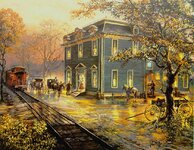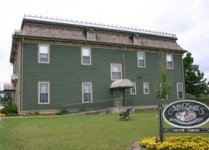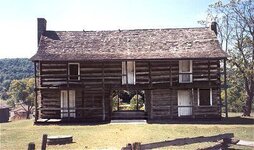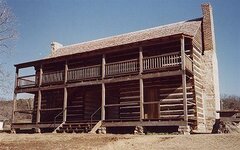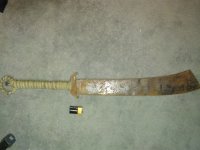Gypsy Heart
Gold Member
Miss Laura's Social Club.....You Can't Keep a Bad Girl Down
........The girls at Miss Laura's were competing with girls from six other houses In the western border town of Fort Smith. Along with the steady flow of men from the fort as well as the river port and railroad, Miss Laura's was a very lucrative business. The men were paying 3.00 for a commodity that was selling for 1.00 at the other houses..........
A Man has one hundred dollars...you leave him two dollars...thats subtraction Mae West
IN 1904, an enterprising prostitute named Laura Ziegler dropped into a local bank, negotiated a $3,000 loan and opened an enduring house of ill repute here in this wicked depot of American frontier history.
Miss Laura's Social Club, as the handsome apple-green, mansard-roofed establishment was known, became the most seductive brothel in a city steamy with bawdy houses. They were arrayed along Bordello Row, an old riverfront strip that glittered with red lights and a supermart of pleasure.
The Mayor attended the opening of Miss Laura's, an upscale manse for a $3-a-transaction trade. It became the baroque Victorian standout among the Row's six other mere $1 brothels and Fort Smith's 66 raucous saloons.
After the women were gone, the two-story clapboard building gained formal respectability in 1973 when, snatched from demolition, it was accepted for entry into the National Register of Historic Places. Later, fittingly enough, the restored brothel became the city's official Visitors Center for strangers looking for a good time.
But last year, a tornado almost accomplished what years of moral crusaders could not, and nearly destroyed Miss Laura's. On Oct. 21, the city's board unanimously approved $698,000 to restore the house, from the player piano banging out a ragtime welcome in the foyer to the bedroom transoms etched with the names of Kitty, Lanna and the other women.
The tornado had ripped off the entire roof, from wrought-iron trim to oeil-de-boeuf (eye of the ox) mansard windows. Five inches of rain had poured through the nine bedroom workplaces, while a whirlwind of red velvet drapes, plush chairs and other period furnishings were sucked out across the countryside.
Miss Laura's had been luckier in the past. Its special place in city legend was already secured on the winter night in 1910 known as ''the night of the lingerie parade.''
That was when a fire roared down Front Street like some biblical comeuppance, routing hurriedly sundered couples into the streets in their underclothes. The flames burned down two brothels but spared Miss Laura's, the fire suddenly diverted as if by the winds of Providence.
''Only 75 feet from our doorstep, a change in the wind, just like the tornado last year,'' said Carolyn Joyce, a rouged, gowned and feathered city tourism worker who regularly loses herself in the costumes and persona of the brothel's founder. ''But this was the queen of the Row, and we're going to have Miss Laura's back and open again,'' she added, as she assayed the severe damage to the city's bordello-turned-Visitors-Center with all the passion of Scarlett railing at Tara's tattered portico.
Ms. Joyce is the keeper of Miss Laura's and the remaining relics of this city's once rampant prostitution industry, from piquant pink garters to the special token coins Miss Laura protectively gave to city V.I.P.'s so they could partake of the pleasure house without being charged.
''I cannot convey to you how excited I am,'' Ms. Joyce said, exulting in her true-life role as the determined madam of the restoration project.
It is an especially delicate task to recreate the roof and its stylized dormer windows set in concave eaves. But the city's devotion to preservation is clear in the two dozen restored houses of the 19th-century Belle Grove Historic District.
''People found pieces of the roof beyond the railroad tracks and dropped them off for us,'' said Galen Hunter, the architect who is redoing the bordello without the original blueprints. ''There were enough scavengings from the roof to enable us to piece together the original design. It's typical Second Empire style.''
Left unbudged by the tornado as reminders of Miss Laura's endurance were the original dining-room table, where the madam fed her employees, and the sideboard from the upstairs corridor, through which decades of lustful, lonely clients passed. The turmoil of some of these nights is suggested by an old city newspaper clipping on the wall: Will Montgomery, described as a young man from Coal Hill, committed suicide with morphine as he lingered on Jan. 14, 1898, at Pearl Starr's, another brothel. It was run by a colleague of Miss Laura's, who was the daughter of Belle Starr, one of the gunslinging terrors of the city's past.
''Most of the girls were from farms around here who came into town to get a job and make a living,'' said Kay Dishner, a local resident, who wrote ''Ladies of the House,'' her master's thesis at Arkansas Tech University, on Miss Laura's bordello. ''Most got married and simply left that life behind. Miss Laura's provides insight into what was normal life for some women then.''
Ms. Dishner has traced a few prostitutes' descendants who are still in town, one of them proudly describing how her father was raised at Miss Laura's after his mother ran away from her husband over in Ozark, Ark., and became pregnant while working at the house. ''She thought the father was a railroad man,'' Ms. Dishner said, noting that trains still run by Miss Laura's with enough noise to keep people up all night.
''You forget how vibrant it all was once,'' Mr. Hunter, the architect, said. ''Researching Miss Laura's, I find prominent citizens in town used to support the place. Some public debate was stirred lately at the idea of restoring a bordello as the city's official visitors center. But most people agreed this really gives us something pretty distinctive.''
After its years of doing business in a fleshpot of American history, Miss Laura's, even in temporary disarray, still displays the grace of an old Mississippi paddle wheeler. The trashed interior has a dark mood of resolve as Ms. Joyce tells respectful tales of ''the girls'' upstairs icing champagne by the bathtubful for ''their boys.'' She has pictures -- stabbing images from the past -- of these anonymous women at their leisure.
''Don't you know we had a great big Dumpster sucked up by the tornado and dropped onto Lanna's bedroom?'' said Ms. Joyce/Miss Laura, lyrical as a Tennessee Williams character traversing the past, her hands flashing rings on eight fingers. She looked in on the ravaged flounce of Lanna's workplace and vowed to have it restored, from washstand to white iron bedstead, by next July.
''And my own sitting room,'' she added of the downstairs living quarters, where Miss Laura ran her business, packing a six-gun in a drawer and enforcing rules that no employee show herself undressed downstairs.
For the bordello restorers, the challenge will be adhering to a new tornado-resistant building code. A firmer foundation will be built; the storm-raked structure will be realigned to plumb, and the rich interior paneling and trim will be temporarily removed so that plywood can be added as bracing. ''We'll strip it to the skeleton, then piece it back,'' Mr. Hunter said. ''We'll replace the wallpaper, going back to a very decorative damask type from that period. And the appropriate decorative borders will be stenciled about the top of the walls.''
Such attention echoes the working days of Miss Laura's, when the city's merchants would discreetly bring their wares to the house rather than have the prostitutes traipse downtown among respectable gentry. It was the modern gentry, however, who saved the building as it stood abandoned and decaying a generation ago. The city's Historic Preservation Society and Donald W. Reynolds, a local businessman, saw the enticement of Miss Laura's.
''Miss Laura's was the jewel of Bordello Row,'' Ms. Dishner said. ''It is the heart of a classic town myth, touched on by so many stories of this city's history.''
After the Civil War, Fort Smith was an Army outpost in the Indian wars that completed the seizure of the country from native tribes. Laura Ziegler, a mysterious woman from Vermont, was a fledgling prostitute, then a manager at a brothel a block away, before she designed her own upscale place convenient to train and boat travelers. As Fort Smith became a boomtown community for settlers, Miss Laura's lent a special meaning to the ''Westward Ho'' cry of manifest destiny.
Miss Laura's sits upon the banks of the Arkansas River, overlooking Oklahoma, which was the explosive Indian territory in the heyday of Fort Smith. Territory marauders found their fun here; settlers were scandalized. President Ulysses S. Grant had to dispatch Isaac C. (Hanging Judge) Parker to introduce some law and order to the territory and a city dubbed Hell on the Border. But the houses of prostitution were spared.
''The judge hanged 79 men but always said he was against capital punishment,'' Ms. Joyce said in her Miss Laura twang, ruminating within the brothel's dank grandeur. ''It was the law that hanged a man, he'd say.'' Judge Parker's court was also the scene of $5 ''fines'' for each prostitute -- a form of graft that institutionalized Bordello Row. ''The madams marched down to jail each month to pay the fine,'' Ms. Dishner said. She has tracked Miss Laura through these old ''arrest'' records as an ambitious prostitute who worked her way up to management.
Miss Laura's place flourished as prostitution outlived the more brazen banditry of the James Gang, the Dalton Gang and the Younger Brothers. The city became settled enough to outlaw prostitution in 1924. But Laura Ziegler, then 50, had already moved on a decade earlier to places unknown. Records show that she turned a handsome profit when she sold her place in 1911 for $47,000 to one of her more enterprising employees, Bertha Gale Dean. Appearing as a zaftig, fierce-faced madam in a surviving photograph, Dean ran the brothel until she died there in 1948.
Miss Bertha's final customers in the dancing parlor and behind the bedroom shades were World War II recruits frisky with weekend passes from nearby Fort Chaffee. Their behavior was overseen by the brothel bouncer, Jules Bartholomew, who was Miss Bertha's companion after the death of her husband, Mack Dean, a local saloonkeeper. ''She was Mack's good and loyal wife,'' Ms. Dishner said, her research lending a wisp of family values to the downstairs scene at Miss Laura's.
In a flashy teal and black gown, Ms. Joyce slipped away into another Miss Laura riff as she bossily roamed the sodden old bordello. Ghost-driven, she left small doubt that she would restore Lanna's bedroom as an enticing tribute to lost time and even reinstate the gaudy mannequin standing in as Lanna.
''Why,'' Ms. Joyce exclaimed, ''we found Lanna spun around several times, and I just could not tell whether it had been a tornado or if the girls had just thrown a big party and blown the roof off.''
;;;;;;;;;;;;;;;;;;;;;;;;;;;;;;;;;;;;
In 1911, after purchasing the property for $3,000, Laura sold the property to one of her girls by the name of Bertha Gale Dean. The selling price was $47,000. Laura left Fort Smith and little is known of her life afterwards.
Right next door to Miss Laura's stood another brothel of some notoriety, owned by Pearl Starr. As you may know, Pearl was the daughter of the "Bandit Queen Belle Star"
Bertha Dean
Born in Kansas in 1882, Bertha Lanthrop began her career as a prostitute around 1900 when she was in her late teens or early twenties. For Bertha, unlike Laura Zeigler (Miss Laura, the first madam at 123 Firs Street), the business of commercial sex was less of a career and more of a way of life. First as a prostitute for Laura Zeigler, then as her successor, Bertha would reside in the bordello at 123 First Street until her death in 1948. Her life on the Row encompassed almost the entire life of the street as the red light district of Fort Smith. She saw the business pass through all its stages.
According to land records, at some time she may have married a man named Jones. Fort Smith marriage records for the time reveal no such union. Either she married the man elsewhere, it was a common law arrangement or she simply was using the surname as a pseudonym. Despite her assuming the name Jones in the land records for 1915, she also continued to use the name Bertha Gale when charged with being a "keeper of a house of prostitution."
Sometime around 1917, Bertha did marry Mack Dean. Dean was an Arkansas native and a veteran of the Spanish-American War. Judging from their sharing of a common plot in the National Cemetery in Fort Smith, this relationship was more than likely a bona fide legal marriage. Tragically for Bertha, it would only last five years. Dean suffered from tuberculosis. Judging from the outpouring of condolence letters to Bertha in 1922, they must have shared a large number of friends. Also at this time, Bertha received two letters from her sister and mother who were living in California. Both of them tried to persuade her to leave Fort Smith and the bordello business without success. In her will, Bertha left the members of her family in California one dollar each, stating that reason for her parsimony was that "they have not assisted me in anyway."
Bertha Dean kept her deceased husband's name despite another relationship with Jules Bartholemy. Bartholemy lived in the brothel, but whether he simply was a bouncer in her employ or more than that is not known. Whatever the case, Bertha left the land and the house to him upon her death in 1948.
Outside of these relationships with the principal men in her life, Bertha Dean was apparently strong-willed, clever business woman much like Laura Zeigler. Possessing a deep, loud voice, locally she became known as "Big Bertha." Photographs that purportedly show her during the 1920s reveal a petite woman with almost delicate features. Not tall in stature, it is probably the weight that she gained late in life when her health began to fail that led people to call her "big."
Bertha Dean's life at 123 First Street must have been a mixture of struggle and success; struggle with police officiers and the Great Depression; financial success enjoying a boom in business from soldiers at Fort Chaffee during World War II. Those same 25 years brought changes in the business of prostitution and new competitors.
One important change was the presence in the city of large hotels. By the 1920s, the Goldman Hotel and the Ward Hotel were firmly established businesses in the city. Porters and telephones in the hotels enabled Bertha Dean to institute a "call girl" service at 123 First Street. Usually a bell hop would call Bertha Dean to send a prostitute to a hotel guest. Bertha Dean would then call a cab that would take the woman to either the Ward or the Goldman. Although it is difficult to determine how much "call girl" business was done from 123 First Street, one cab driver states the he made approximately one trip to from the address to a hotel every 10 days; this out of a cab fleet of about 20 cars.
During the 1920s, Bertha Dean initiated a relationship with a local hairdresser, Sammie Peters Long. Whenever a new woman came to work at 123 First, Bertha would send her over to Sammie Long's beauty parlor on Garrison Avenue. There, Sammie Long would dye every new prostitute's hair upon the request of the madam, teach the new employees how to sit and teach them proper etiquette. One of her recollections is how Bertha Dean used to complain in an exasperated tone of another madam on First Street, Ella Scott.
By the late 1930s, Ella Scott was Bertha Dean's only remaining competition on the Row; although Scott did not use call girls. Between the time of the late teens and the end of the 1920s, the other bordellos had closed. Probably never more than ten in number, police pressure and economic forces pushed them out. Railroad tracks covered the sites of the houses and new owners and locations took up the business. Reportedly, "crime syndicates" and pimps conducted commercial sex enterprises out of hotels on North Fifth Street. The time when women could control the business of prostitution was almost past.
As Bertha Dean entered the 1940s and the last years of her life, business at 123 First Street enjoyed one last period of properity. Soldiers from Fort Chaffee, constructed in the late 1930s on the outskirts of the city, frequented the house. In the history of the settlement of the western frontier, even near very remote military outposts, prostitutes did business. Doubtless they worked in Fort Smith even in the 1840s. In the 1940s, in what is today the city's most celebrated bordello,soldiers appeared again. Into the 1950s and 1960s, military men in the area probably continued to visit houses of prostitution. But with the conclusion of World War II, fewer came to 123 First Street. Bertha Dean's health began to fail and in 1948, at the age of 66, she died. Perhaps it is fitting that as a representative of all the madams and prostitutes of Fort Smith, she is buried with soldiers, the kind of men who founded Fort Smith and were her customers. Her body lies in the city's National Cemetery in section 1, plot 472.
Gallery
Source:
"Living Under a Red Light, Fort Smith's Bordello Row, 1898 to 1948," Benjamin Boulden.
From a 1994 study sponsored by a grant from the Arkansas Historic Preservation Program.
........The girls at Miss Laura's were competing with girls from six other houses In the western border town of Fort Smith. Along with the steady flow of men from the fort as well as the river port and railroad, Miss Laura's was a very lucrative business. The men were paying 3.00 for a commodity that was selling for 1.00 at the other houses..........
A Man has one hundred dollars...you leave him two dollars...thats subtraction Mae West
IN 1904, an enterprising prostitute named Laura Ziegler dropped into a local bank, negotiated a $3,000 loan and opened an enduring house of ill repute here in this wicked depot of American frontier history.
Miss Laura's Social Club, as the handsome apple-green, mansard-roofed establishment was known, became the most seductive brothel in a city steamy with bawdy houses. They were arrayed along Bordello Row, an old riverfront strip that glittered with red lights and a supermart of pleasure.
The Mayor attended the opening of Miss Laura's, an upscale manse for a $3-a-transaction trade. It became the baroque Victorian standout among the Row's six other mere $1 brothels and Fort Smith's 66 raucous saloons.
After the women were gone, the two-story clapboard building gained formal respectability in 1973 when, snatched from demolition, it was accepted for entry into the National Register of Historic Places. Later, fittingly enough, the restored brothel became the city's official Visitors Center for strangers looking for a good time.
But last year, a tornado almost accomplished what years of moral crusaders could not, and nearly destroyed Miss Laura's. On Oct. 21, the city's board unanimously approved $698,000 to restore the house, from the player piano banging out a ragtime welcome in the foyer to the bedroom transoms etched with the names of Kitty, Lanna and the other women.
The tornado had ripped off the entire roof, from wrought-iron trim to oeil-de-boeuf (eye of the ox) mansard windows. Five inches of rain had poured through the nine bedroom workplaces, while a whirlwind of red velvet drapes, plush chairs and other period furnishings were sucked out across the countryside.
Miss Laura's had been luckier in the past. Its special place in city legend was already secured on the winter night in 1910 known as ''the night of the lingerie parade.''
That was when a fire roared down Front Street like some biblical comeuppance, routing hurriedly sundered couples into the streets in their underclothes. The flames burned down two brothels but spared Miss Laura's, the fire suddenly diverted as if by the winds of Providence.
''Only 75 feet from our doorstep, a change in the wind, just like the tornado last year,'' said Carolyn Joyce, a rouged, gowned and feathered city tourism worker who regularly loses herself in the costumes and persona of the brothel's founder. ''But this was the queen of the Row, and we're going to have Miss Laura's back and open again,'' she added, as she assayed the severe damage to the city's bordello-turned-Visitors-Center with all the passion of Scarlett railing at Tara's tattered portico.
Ms. Joyce is the keeper of Miss Laura's and the remaining relics of this city's once rampant prostitution industry, from piquant pink garters to the special token coins Miss Laura protectively gave to city V.I.P.'s so they could partake of the pleasure house without being charged.
''I cannot convey to you how excited I am,'' Ms. Joyce said, exulting in her true-life role as the determined madam of the restoration project.
It is an especially delicate task to recreate the roof and its stylized dormer windows set in concave eaves. But the city's devotion to preservation is clear in the two dozen restored houses of the 19th-century Belle Grove Historic District.
''People found pieces of the roof beyond the railroad tracks and dropped them off for us,'' said Galen Hunter, the architect who is redoing the bordello without the original blueprints. ''There were enough scavengings from the roof to enable us to piece together the original design. It's typical Second Empire style.''
Left unbudged by the tornado as reminders of Miss Laura's endurance were the original dining-room table, where the madam fed her employees, and the sideboard from the upstairs corridor, through which decades of lustful, lonely clients passed. The turmoil of some of these nights is suggested by an old city newspaper clipping on the wall: Will Montgomery, described as a young man from Coal Hill, committed suicide with morphine as he lingered on Jan. 14, 1898, at Pearl Starr's, another brothel. It was run by a colleague of Miss Laura's, who was the daughter of Belle Starr, one of the gunslinging terrors of the city's past.
''Most of the girls were from farms around here who came into town to get a job and make a living,'' said Kay Dishner, a local resident, who wrote ''Ladies of the House,'' her master's thesis at Arkansas Tech University, on Miss Laura's bordello. ''Most got married and simply left that life behind. Miss Laura's provides insight into what was normal life for some women then.''
Ms. Dishner has traced a few prostitutes' descendants who are still in town, one of them proudly describing how her father was raised at Miss Laura's after his mother ran away from her husband over in Ozark, Ark., and became pregnant while working at the house. ''She thought the father was a railroad man,'' Ms. Dishner said, noting that trains still run by Miss Laura's with enough noise to keep people up all night.
''You forget how vibrant it all was once,'' Mr. Hunter, the architect, said. ''Researching Miss Laura's, I find prominent citizens in town used to support the place. Some public debate was stirred lately at the idea of restoring a bordello as the city's official visitors center. But most people agreed this really gives us something pretty distinctive.''
After its years of doing business in a fleshpot of American history, Miss Laura's, even in temporary disarray, still displays the grace of an old Mississippi paddle wheeler. The trashed interior has a dark mood of resolve as Ms. Joyce tells respectful tales of ''the girls'' upstairs icing champagne by the bathtubful for ''their boys.'' She has pictures -- stabbing images from the past -- of these anonymous women at their leisure.
''Don't you know we had a great big Dumpster sucked up by the tornado and dropped onto Lanna's bedroom?'' said Ms. Joyce/Miss Laura, lyrical as a Tennessee Williams character traversing the past, her hands flashing rings on eight fingers. She looked in on the ravaged flounce of Lanna's workplace and vowed to have it restored, from washstand to white iron bedstead, by next July.
''And my own sitting room,'' she added of the downstairs living quarters, where Miss Laura ran her business, packing a six-gun in a drawer and enforcing rules that no employee show herself undressed downstairs.
For the bordello restorers, the challenge will be adhering to a new tornado-resistant building code. A firmer foundation will be built; the storm-raked structure will be realigned to plumb, and the rich interior paneling and trim will be temporarily removed so that plywood can be added as bracing. ''We'll strip it to the skeleton, then piece it back,'' Mr. Hunter said. ''We'll replace the wallpaper, going back to a very decorative damask type from that period. And the appropriate decorative borders will be stenciled about the top of the walls.''
Such attention echoes the working days of Miss Laura's, when the city's merchants would discreetly bring their wares to the house rather than have the prostitutes traipse downtown among respectable gentry. It was the modern gentry, however, who saved the building as it stood abandoned and decaying a generation ago. The city's Historic Preservation Society and Donald W. Reynolds, a local businessman, saw the enticement of Miss Laura's.
''Miss Laura's was the jewel of Bordello Row,'' Ms. Dishner said. ''It is the heart of a classic town myth, touched on by so many stories of this city's history.''
After the Civil War, Fort Smith was an Army outpost in the Indian wars that completed the seizure of the country from native tribes. Laura Ziegler, a mysterious woman from Vermont, was a fledgling prostitute, then a manager at a brothel a block away, before she designed her own upscale place convenient to train and boat travelers. As Fort Smith became a boomtown community for settlers, Miss Laura's lent a special meaning to the ''Westward Ho'' cry of manifest destiny.
Miss Laura's sits upon the banks of the Arkansas River, overlooking Oklahoma, which was the explosive Indian territory in the heyday of Fort Smith. Territory marauders found their fun here; settlers were scandalized. President Ulysses S. Grant had to dispatch Isaac C. (Hanging Judge) Parker to introduce some law and order to the territory and a city dubbed Hell on the Border. But the houses of prostitution were spared.
''The judge hanged 79 men but always said he was against capital punishment,'' Ms. Joyce said in her Miss Laura twang, ruminating within the brothel's dank grandeur. ''It was the law that hanged a man, he'd say.'' Judge Parker's court was also the scene of $5 ''fines'' for each prostitute -- a form of graft that institutionalized Bordello Row. ''The madams marched down to jail each month to pay the fine,'' Ms. Dishner said. She has tracked Miss Laura through these old ''arrest'' records as an ambitious prostitute who worked her way up to management.
Miss Laura's place flourished as prostitution outlived the more brazen banditry of the James Gang, the Dalton Gang and the Younger Brothers. The city became settled enough to outlaw prostitution in 1924. But Laura Ziegler, then 50, had already moved on a decade earlier to places unknown. Records show that she turned a handsome profit when she sold her place in 1911 for $47,000 to one of her more enterprising employees, Bertha Gale Dean. Appearing as a zaftig, fierce-faced madam in a surviving photograph, Dean ran the brothel until she died there in 1948.
Miss Bertha's final customers in the dancing parlor and behind the bedroom shades were World War II recruits frisky with weekend passes from nearby Fort Chaffee. Their behavior was overseen by the brothel bouncer, Jules Bartholomew, who was Miss Bertha's companion after the death of her husband, Mack Dean, a local saloonkeeper. ''She was Mack's good and loyal wife,'' Ms. Dishner said, her research lending a wisp of family values to the downstairs scene at Miss Laura's.
In a flashy teal and black gown, Ms. Joyce slipped away into another Miss Laura riff as she bossily roamed the sodden old bordello. Ghost-driven, she left small doubt that she would restore Lanna's bedroom as an enticing tribute to lost time and even reinstate the gaudy mannequin standing in as Lanna.
''Why,'' Ms. Joyce exclaimed, ''we found Lanna spun around several times, and I just could not tell whether it had been a tornado or if the girls had just thrown a big party and blown the roof off.''
;;;;;;;;;;;;;;;;;;;;;;;;;;;;;;;;;;;;
In 1911, after purchasing the property for $3,000, Laura sold the property to one of her girls by the name of Bertha Gale Dean. The selling price was $47,000. Laura left Fort Smith and little is known of her life afterwards.
Right next door to Miss Laura's stood another brothel of some notoriety, owned by Pearl Starr. As you may know, Pearl was the daughter of the "Bandit Queen Belle Star"
Bertha Dean
Born in Kansas in 1882, Bertha Lanthrop began her career as a prostitute around 1900 when she was in her late teens or early twenties. For Bertha, unlike Laura Zeigler (Miss Laura, the first madam at 123 Firs Street), the business of commercial sex was less of a career and more of a way of life. First as a prostitute for Laura Zeigler, then as her successor, Bertha would reside in the bordello at 123 First Street until her death in 1948. Her life on the Row encompassed almost the entire life of the street as the red light district of Fort Smith. She saw the business pass through all its stages.
According to land records, at some time she may have married a man named Jones. Fort Smith marriage records for the time reveal no such union. Either she married the man elsewhere, it was a common law arrangement or she simply was using the surname as a pseudonym. Despite her assuming the name Jones in the land records for 1915, she also continued to use the name Bertha Gale when charged with being a "keeper of a house of prostitution."
Sometime around 1917, Bertha did marry Mack Dean. Dean was an Arkansas native and a veteran of the Spanish-American War. Judging from their sharing of a common plot in the National Cemetery in Fort Smith, this relationship was more than likely a bona fide legal marriage. Tragically for Bertha, it would only last five years. Dean suffered from tuberculosis. Judging from the outpouring of condolence letters to Bertha in 1922, they must have shared a large number of friends. Also at this time, Bertha received two letters from her sister and mother who were living in California. Both of them tried to persuade her to leave Fort Smith and the bordello business without success. In her will, Bertha left the members of her family in California one dollar each, stating that reason for her parsimony was that "they have not assisted me in anyway."
Bertha Dean kept her deceased husband's name despite another relationship with Jules Bartholemy. Bartholemy lived in the brothel, but whether he simply was a bouncer in her employ or more than that is not known. Whatever the case, Bertha left the land and the house to him upon her death in 1948.
Outside of these relationships with the principal men in her life, Bertha Dean was apparently strong-willed, clever business woman much like Laura Zeigler. Possessing a deep, loud voice, locally she became known as "Big Bertha." Photographs that purportedly show her during the 1920s reveal a petite woman with almost delicate features. Not tall in stature, it is probably the weight that she gained late in life when her health began to fail that led people to call her "big."
Bertha Dean's life at 123 First Street must have been a mixture of struggle and success; struggle with police officiers and the Great Depression; financial success enjoying a boom in business from soldiers at Fort Chaffee during World War II. Those same 25 years brought changes in the business of prostitution and new competitors.
One important change was the presence in the city of large hotels. By the 1920s, the Goldman Hotel and the Ward Hotel were firmly established businesses in the city. Porters and telephones in the hotels enabled Bertha Dean to institute a "call girl" service at 123 First Street. Usually a bell hop would call Bertha Dean to send a prostitute to a hotel guest. Bertha Dean would then call a cab that would take the woman to either the Ward or the Goldman. Although it is difficult to determine how much "call girl" business was done from 123 First Street, one cab driver states the he made approximately one trip to from the address to a hotel every 10 days; this out of a cab fleet of about 20 cars.
During the 1920s, Bertha Dean initiated a relationship with a local hairdresser, Sammie Peters Long. Whenever a new woman came to work at 123 First, Bertha would send her over to Sammie Long's beauty parlor on Garrison Avenue. There, Sammie Long would dye every new prostitute's hair upon the request of the madam, teach the new employees how to sit and teach them proper etiquette. One of her recollections is how Bertha Dean used to complain in an exasperated tone of another madam on First Street, Ella Scott.
By the late 1930s, Ella Scott was Bertha Dean's only remaining competition on the Row; although Scott did not use call girls. Between the time of the late teens and the end of the 1920s, the other bordellos had closed. Probably never more than ten in number, police pressure and economic forces pushed them out. Railroad tracks covered the sites of the houses and new owners and locations took up the business. Reportedly, "crime syndicates" and pimps conducted commercial sex enterprises out of hotels on North Fifth Street. The time when women could control the business of prostitution was almost past.
As Bertha Dean entered the 1940s and the last years of her life, business at 123 First Street enjoyed one last period of properity. Soldiers from Fort Chaffee, constructed in the late 1930s on the outskirts of the city, frequented the house. In the history of the settlement of the western frontier, even near very remote military outposts, prostitutes did business. Doubtless they worked in Fort Smith even in the 1840s. In the 1940s, in what is today the city's most celebrated bordello,soldiers appeared again. Into the 1950s and 1960s, military men in the area probably continued to visit houses of prostitution. But with the conclusion of World War II, fewer came to 123 First Street. Bertha Dean's health began to fail and in 1948, at the age of 66, she died. Perhaps it is fitting that as a representative of all the madams and prostitutes of Fort Smith, she is buried with soldiers, the kind of men who founded Fort Smith and were her customers. Her body lies in the city's National Cemetery in section 1, plot 472.
Gallery
Source:
"Living Under a Red Light, Fort Smith's Bordello Row, 1898 to 1948," Benjamin Boulden.
From a 1994 study sponsored by a grant from the Arkansas Historic Preservation Program.


